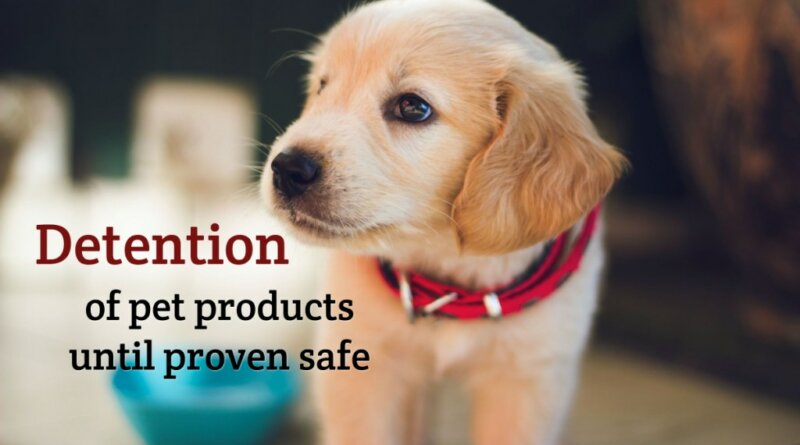The FDA’s Red List – Truth about Pet Food
On February 16, 2022 the FDA posted an “Import Alert” named “Detention Without Physical Examination of Pig Ears and Other Pet Treats Due to the Presence Of Salmonella.”
The FDA gives explanation for the alert that the treats have a history of contamination with Salmonella, imported from numerous countries.
The import alert explains: “Divisions may detain, without physical examination, the identified pet treat products from the firms listed on the Red List of this import alert.”
FDAImports.com describes an FDA Red List as “companies or products that FDA has discovered (usually by testing imported products or inspecting documents or the facility) have previously exported unsafe, adulterated, misbranded, or unapproved products. Red listed companies cannot freely import into the U.S.”
With this pet treat Red List, the FDA has included the names of many pet treat firms that have previously exported adulterated treats into the US. The Red List includes numerous companies from each of the following countries: Argentina, Australia, Bangladesh, Brazil, Canada, Chile, China, Columbia, Germany, Hong Kong, Iceland, India, Kyrgystan, Mexico, Nepal, New Zealand, Paraguay, Peru, Portugal, South Africa, Spain, Taiwan, Thailand, Turkey, Venezuela, and Vietnam.
Being on the Red List requires a company to prove to the FDA their products are safe and the company has corrected the problem – in this case the pathogenic bacteria problem – before the company is allowed to distribute and sell their products to pet owners.
The FDA requires companies on the Red List to…
“1. The firm must provide evidence that it has identified the source of the problem and has taken appropriate steps to prevent future occurrences. This should be documented by:
a. Results of the firm’s investigation(s) into the problem of Salmonella contamination.
b. Documentation showing corrective action(s). This should include at a minimum:
1) a description of the current process(es) being used;
2) verification that the process is adequate; and
3) measures that have been taken to prevent recontamination.
c. Copies of three (3) production records showing at a minimum, the process, quantities processed, lot numbers and dates of processing,
AND
2. Requests to remove a single product will require documentation showing that a minimum of five (5) consecutive, non-violative shipments have been released based on private laboratory analyses. Requests to remove multiple products from a manufacturer will require a minimum of twelve (12) non-violative shipments representative of products covered by detention without physical examination.“
The Red List program appears to be a great effort by FDA to hold manufacturers accountable for the safety of their products. But…
Why isn’t there a Red List program for made in the US and distributed in the US pet products?
As example…
What if after the Hill’s Science Diet excess vitamin D recall in 2019, Hill’s was put on a US made and distributed Red List. What if Hill’s could not distribute any pet food following that recall until they proved to FDA “appropriate steps to prevent future occurrences” were taken. What if Hill’s had to provide to FDA independent lab results that a minimum of five consecutive batches of pet food contained proper levels of vitamin D before they could put any pet food back on store shelves.
Or…what if Midwestern Pet Food – after the December 2020 aflatoxin recall would have been put on a Red List. What if they would have been required to withdraw all pet products from store shelves until they proved they would properly test their pet foods preventing another deadly recall.
And…what if there was a US made and distributed pet product Red List that any pet owner could publicly access – see the names of all of the brands of products that are known by FDA to have sold a risk product, and are forced to prove to the agency they have corrected the problem.
How many pet’s lives would be saved if FDA held US manufactured and distributed pet foods/treats to the same safety standards they are holding imported pet treats to? Why isn’t this same program applied uniformly across all pet products for all risks (not solely Salmonella)?
If you’d like to see the FDA’s Red List applied to all pet products, both imported and made in the US, for all known risks – please tell the FDA. Send them an email at: AskCVM@fda.hhs.gov.
Wishing you and your pet the best –
Susan Thixton
Pet Food Safety Advocate
TruthaboutPetFood.com
Association for Truth in Pet Food

Become a member of our pet food consumer Association. Association for Truth in Pet Food is a a stakeholder organization representing the voice of pet food consumers at AAFCO and with FDA. Your membership helps representatives attend meetings and voice consumer concerns with regulatory authorities. Click Here to learn more.
What’s in Your Pet’s Food?
Is your dog or cat eating risk ingredients? Chinese imports? Petsumer Report tells the ‘rest of the story’ on over 5,000 cat foods, dog foods, and pet treats. 30 Day Satisfaction Guarantee. Click Here to preview Petsumer Report. www.PetsumerReport.com
Find Healthy Pet Foods in Your Area Click Here

The 2022 List
Susan’s List of trusted pet foods. Click Here to learn more.




